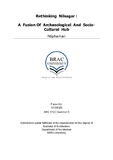Rethinking Nilsagar : a fusion of archaeological and socio- cultural hub Nilphamari
Abstract
Our country has a long history of enriched civilization and
culture. Many historical and archeological places didn’t get focused and
conserved. Nilsagar is from 10 to 11 century and built for the general people.
The archeological evidence of the ghat and other findings of that area is the
evidence of their culture, tradition and their way of life.
In order to stay close to the fundamentals of the site, the local
context played the key role in paving the design development. For instance,
following the diction in which temples and traces of embankment have been
found since its inception in 2016, the possibility of excavating yet another temple
in the vicinity is undeniable. Predicted to be built during the Gupta and Pala
reigns, and hence of substantial archaeological significance, this factor has been
catered to with utmost importance. In fact, in light of this, the preexisting
religious center consisting of a temple which serves as the heart of the Mela and
hence acts as a socio cultural hub, has been shifted to the opposite side of the
embankment. The dighi serves as a core deciding factor of the process – while it
divides the archaeological hub and the socio-cultural hub visually, it also connects
them and thus enhances the experience and promotes people’s participation. The
design essentially explores the possibilities of a culture rooted deep in history
while emphasizing on the archaeological prospects by exposing it to a wider
population.

